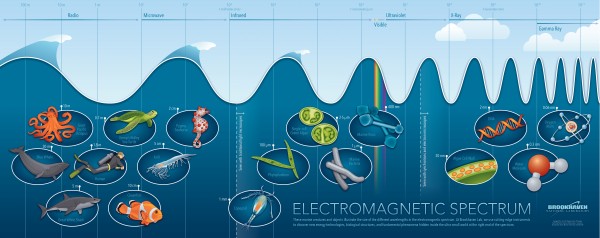Infographic: Dive Deep Into the Electromagnetic Spectrum

Brookhaven National Laboratory The wavelengths of the electromagnetic spectrum illustrated by ocean creatures and objects.
It can be difficult in our everyday lives to appreciate the extraordinary range of wavelengths in the electromagnetic spectrum. Electromagnetic radiation—from radio waves to visible light to x-rays—rises and falls as it travels through space, like waves rippling across the ocean.
The length of these waves—measured from peak to peak or valley to valley—helps define their properties and potential uses.
This infographic uses ocean creatures and objects to express these different wavelengths, which can actually stretch to sizes both larger and smaller than this image conveys. Many of these objects, including the 30-meter blue whale or the 2-centimeter pygmy seahorse, can be easily seen with the naked eye.
But scientists and students must use microscopes and similar devices to see the objects in the middle of the spectrum, including algae and viruses. At the right end of the spectrum, however, much more sophisticated instruments are required.
Brookhaven Lab specializes in exploring materials on the nanoscale, spanning just billionths of a meter. To reveal structural details the size of DNA, we use powerful x-rays produced at the National Synchrotron Light Source II, precise electron microscopes at the Center for Functional Nanomaterials, and a host of other sensitive instruments and techniques.
Investigating materials at that scale—from lithium-ion batteries to cell-building proteins—allows fundamental discoveries that can revolutionize our understanding of biology, energy technology, and even the cosmos.
In fact, Brookhaven Lab scientists use the Relativistic Heavy Ion Collider to explore subatomic phenomena spanning just millionths of a billionth of a meter—too small to fit onto this graphic of the electromagnetic spectrum produced by Media & Communications and Creative Resources' designer Tiffany Bowman and science writer Justin Eure, in collaboration with our researchers.
Grab the full, poster-size image on Brookhaven's Flickr.
Contact Information
Justin Eure
Public Affairs Representative
jeure@bnl.gov
Media Contact
More Information:
http://www.bnl.govAll latest news from the category: Life Sciences and Chemistry
Articles and reports from the Life Sciences and chemistry area deal with applied and basic research into modern biology, chemistry and human medicine.
Valuable information can be found on a range of life sciences fields including bacteriology, biochemistry, bionics, bioinformatics, biophysics, biotechnology, genetics, geobotany, human biology, marine biology, microbiology, molecular biology, cellular biology, zoology, bioinorganic chemistry, microchemistry and environmental chemistry.
Newest articles

Superradiant atoms could push the boundaries of how precisely time can be measured
Superradiant atoms can help us measure time more precisely than ever. In a new study, researchers from the University of Copenhagen present a new method for measuring the time interval,…

Ion thermoelectric conversion devices for near room temperature
The electrode sheet of the thermoelectric device consists of ionic hydrogel, which is sandwiched between the electrodes to form, and the Prussian blue on the electrode undergoes a redox reaction…

Zap Energy achieves 37-million-degree temperatures in a compact device
New publication reports record electron temperatures for a small-scale, sheared-flow-stabilized Z-pinch fusion device. In the nine decades since humans first produced fusion reactions, only a few fusion technologies have demonstrated…





















